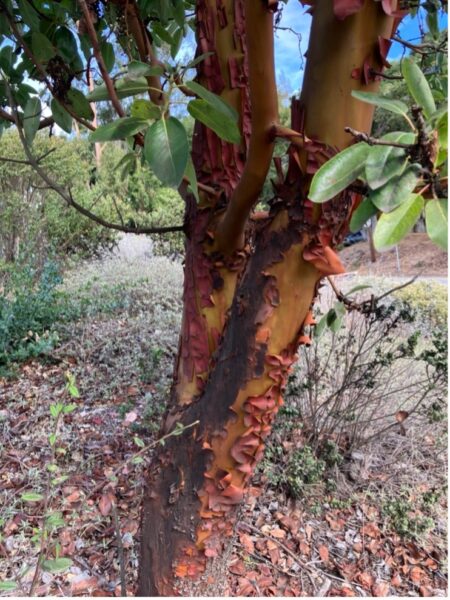
Bark and its Response to Environmental Fluctuations
Director Lew Feldman
Bark is the outer layer of most woody eudicot and gymnosperm trees that show an increase in stem (trunk) diameter. Because bark is directly exposed to the external environment, it often functions to mitigate the numerous environmental “insults” encountered by the plant. Indeed, the type of functions that bark assumes is often related to the ecology of the area in which the plant grows.
A good example of this relationship is seen in trees bearing a thick covering of bark. Here in California, natural fires often occur in redwood and ponderosa pine forests. In this type of environment, the thick layer of bark serves to insulate the inner living tissues from the heat of passing grassland fires. Trees with thick bark can survive these fires, and benefit from the reduction of competition for water and nutrients no longer taken up by the eliminated grasses. Perhaps the classic example of bark functioning to insulate trees from fires is found in the cork oak (Quercus suber), in the Crops of the World Garden of the Botanical Garden) pictured below. In this plant the thick layer of bark is mainly composed of a special (dead) cell type known as cork, which is an excellent insulator against the heat of passing grassland fires.

On the left, a cork oak tree, (Quercus suber) with its thick layer of corky bark enveloping the tree (left). On the right is a cross section of a trunk showing the thickness of the corky bark layer, which insulates the inner, living tissues (yellow arrow) from the heat of fires.
While the bark of most trees is composed mainly of dead cells, there are some exceptions, including the Australian Bottle Tree (Brachychiton rupestris), found in the Australasian Collection of the Garden. This plant grows in regions of Australia in which there are frequent droughts. To conserve water, the Brachychiton often sheds it leaves and remains leafless. But to survive the plant still needs to undergo photosynthesis. How can this happen without leaves? In Australian Bottle Tree the bark is alive and green and is the site of photosynthesis.

Green, living, photosynthesizing bark of Australian Bottle Tree (Brachychiton rupestris)
Another way bark functions is to discourage or to prevent animals from climbing up the tree trunk and eating the fruits, seeds and foliage. The outgrowth of spines, thorns and prickles, of various origins, from the bark of some trees serves as a defense mechanism. In the Garden we have a number of species in which the bark is decorated by spiny outgrowths, including Aralia chinensis, found in the Asian Collection of the Garden and pictured below.

Bark of Aralia chinensis bearing spiny outgrowths which function to retard climbing predators
In some species the functioning of bark is related to its loss, or shedding, such as in Eucalyptus and Arbutus. Two suggestions have been advanced for the purpose of shedding bark. The first relates to the need to maintain a thin layer of bark so that oxygen can more easily reach the inner living tissues, whereas the second suggestion posits that by periodically shedding its bark, trees prevent the accumulation of parasites, including the eggs laid by many insects on bark.

Peeling (exfoliating) bark on Pacific madrone (Arbutus menziesii), native to California and found from British Columbia to Baja
But most trees do not shed their bark, which can thus act as a barrier for oxygen entry into the plant. Therefore, to facilitate oxygen entry to the inner, living tissues, plants have developed special pores, called lenticels. These provide a pathway for oxygen to move across the bark barrier. Lenticels appear as “dimples” or grooves on the bark of many plants and span the bark from the outside to the interior, living cells.

Lenticels on the bark of trees of birch (Betula, left) and cherry (Prunus, right)
For more information about bark, see Bark: the formation, characteristics, and uses of bark around the world, by KB Sandved, G.T. Prance, and A.E. Prance, 1993, Timber Press
